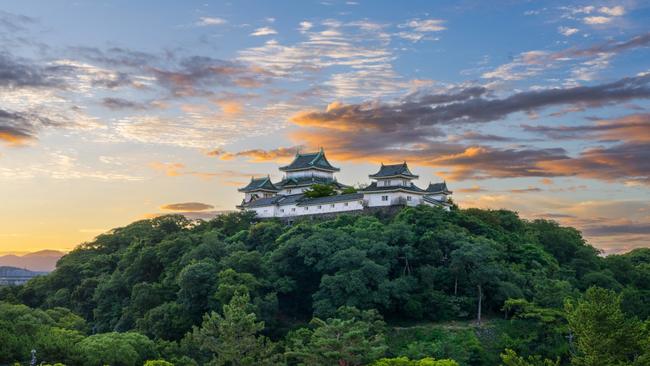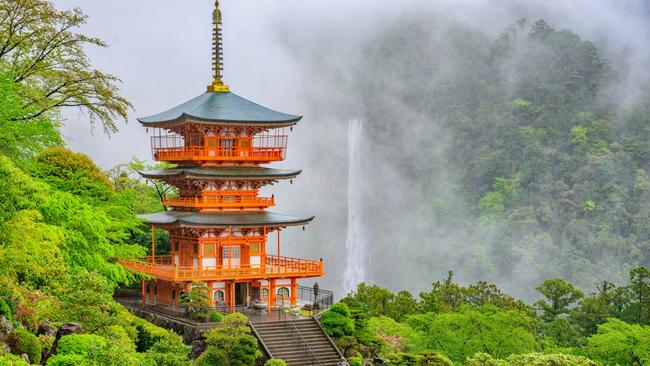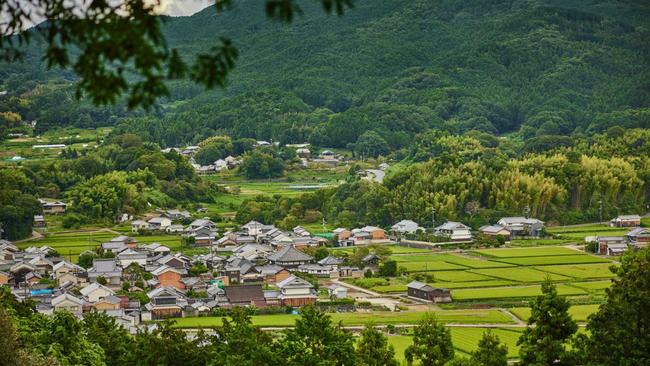A guide to Japan's Kii Peninsula
Japan’s Kii Peninsula is an under-the-radar region dotted with ancient pilgrimage trails, charming villages and mystical temples. I venture into the spiritual heartland, where nature and tradition intertwine.

Lifestyle
Don't miss out on the headlines from Lifestyle. Followed categories will be added to My News.
My fate, it seems, comes down to a stone in a small wooden cage. “This stone weighs as much as your sins,” the monk tells us. We all lean closer, mentally tallying up everything we’ve ever done wrong. There’s a lot to count. The monk grins, his face mask slung under his chin like a pointed white goatee. “Try and lift the stone onto the upper platform. The more virtuous you are, the lighter the stone feels.” A crowd has gathered, listening intently, but no one moves. “Anyone want to try it? How about you?” He points at me.

Putting my hand through the small cage opening, I feel the stone. It’s cool and smooth like an ostrich egg, but so heavy I can barely wriggle my fingers underneath. I manage to heft it slightly before it clatters to one side. Evidently my sins outweigh my strength.
I ask Nobuhiro Tamura, the monk and our guide, if he can do it. He reaches into the cage and effortlessly lifts the stone onto the platform. “I got lucky,” he says shrugging with the charming guile of a well-practised carnival worker who makes their living demonstrating how to do seemingly impossible tricks.

Like the smooth miroku-ishi stone, there’s something deeply mythical about Japan‘s Kii Peninsula, a region encompassing Wakayama and the southern part of Nara and Mie prefectures. Tucked away from the neon-lit cities and mass tourism’s crush, the Kii Peninsula is a land of sacred trails, misty mountains and peaceful retreat for those who want to connect with nature and themselves.
Koyasan is the centre of Shingon Buddhism in Japan and the place where Buddhist monk Kobo Daishi established a monastery deep in the mountains 12 centuries ago. Just metres from where I’ve tried to prove my virtue by lifting the miroku-ishi stone, a path flanked by towering trees and ancient moss-draped monuments leads to the mausoleum where the revered spiritual leader is said to be in eternal meditation.

Faith in Kobo Daishi has attracted people to this area for over 1000 years, including pilgrims walking the Kumano Kodo, which is one of two UNESCO designated pilgrimage paths in the world (the other being Spain’s Camino de Santiago). As I travel around the Kii Peninsula, including a section of the pilgrim path, I spot jizo, small stone statues nestled in the forests, which are believed to protect children and travellers. It feels like a good omen for my trip through this region, where nature is as powerful as any god or deity.
Nature’s might is on full view at Hashigui-Iwa Rock, where a semicircle of pyramid-shaped rocks juts out of the glimmering ocean. Studded in the sand is a tumble of huge boulders, a result of furious tsunamis. “Nature can impact us in such dangerous ways so we pray to the sky, the sea, mountains, rocks and rivers,” says guide Sonoyo Minami.

This is sacred land. Everywhere I go, I see shimenawa - straw or hemp ropes looped around the belly of rocks and trees or strung between the pillars of Shinto torii gates. These special ropes serve as the boundary between the places of the gods, and the profane, outside world. It’s a constant reminder of the way locals balance their gratitude for the natural world as well as respecting nature’s strength.
The region’s beauty is encapsulated in Yoshino, a mountain town best known for its 30,000 cherry blossom trees, but whose cultural roots extend far beneath the surface. Checking into Yoshinosou Yukawaya, a traditional ryokan (Japanese inn), I soak up tranquil mountain views while sampling some of the tastiest and most beautifully presented Japanese food I’ve eaten. At Kadohama Odawara-Dori shop, I learn how to make goma tofu, a traditional food in shojin ryori (vegetarian Buddhist cuisine), where rather than soybeans, sesame seeds are used together with local kuzu (arrowroot starch).

Later, inside a humble home tucked in the hills, plunging my hands into a trough filled with paper fibre, tree bark pulp and cold water, I learn the ancient art of making washi (Japanese traditional paper). My teacher is Mr Masayuki Fukunishi, a sixth-generation washi maker and designated living national treasure whose rare, handmade uda paper has been used for restoration projects in the British Museum and New York’s Metropolitan Museum of Art.
I spend one of my last nights in Japan in the village of Asuka. One morning, just as the sun hits the top of the tiled roofs of the historic old centre, I visit Asuka Niimasu Shrine. There, at the top of the stairs is a red metal box with a stone in it. Using Google translate I read the sign. “It is said that if a woman can hold this stone up with her right hand, happiness will be found.”

I look around. There’s no crowd and no monk to show me how it's done. I reach in, spreading my fingers under the rock. Rivulets of sun stream through the trees and close by monks are chanting. For a full second I manage to lift the heavy stone and, in that brief moment, I feel lighter and stronger than ever.
Escape route
The Kii Peninsula is a region accessible from Kansai and Nanki Shirahama airports, Nara station and Iseshi station.
Lindy Alexander was a guest of Kii Peninsula.
Originally published as A guide to Japan's Kii Peninsula




